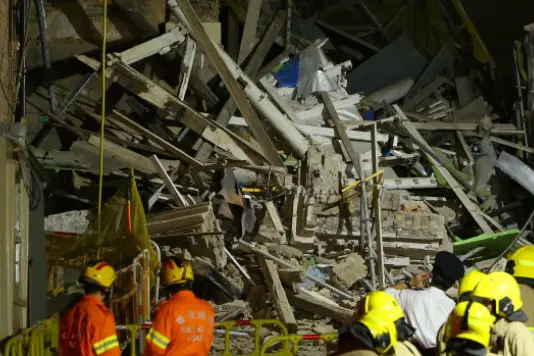Ted Hui Chi-fung says incident at site of heritage revitalisation project "shows failure of government's conservation policy"
The historic building that partially collapsed in the former Central Police Station compound on Sunday night had been flagged two weeks ago as a vulnerable structure that was in “relatively poor condition”, it emerged yesterday.
Emergency crews combed the rubble with sniffer dogs yesterday, even though they did not expect to find anyone.
The accident, just over a week after the collapse of a green roof at City University, has raised public concerns about safety as well as government heritage conservation efforts.
No one was injured in the collapse on Hollywood Road within a fenced-off construction site, where the Jockey Club is leading a HK$1.8 billion project to revitalise the 150-year-old compound. It was fully decommissioned in 2006.
After a wall and part of the roof of the former married inspectors’ quarters came crashing down, it was revealed that it was in the worst condition, due to poor-quality bricks, among the 16 historic buildings in the compound.
Experts believe unstable foundations may also be to blame.
According to a document submitted by the Development Bureau to the Central and Western district council for a meeting on May 19, the married quarters and the former Central Magistracy had “a complex configuration” and might require “more time for restoration”.
The married quarters were built between 1862 and 1864 – among the oldest of the blocks–and were slated for redevelopment into an office for an NGO and a visitor centre.
According to the document, progress was “in accordance with the restoration plan”, with the compound scheduled to be opened to the public late this year.
Architectural expert Lee Ho-yin, who headed the project’s heritage working group, said problems with the quarters had been known for a long time.
“It has the most problems among the 16 buildings, as both materials and construction were not up to standard,” Lee, an architectural conservation scholar at the University of Hong Kong, said. He said the use of local green bricks for buildings three to four storeys tall was problematic, noting that this had been known since the start of revitalisation work in 2011.
Greg Wong Chak-yan, former president of the Institution of Engineers, speculated: “The collapse of one wall might be because of subsidence or inclination of the building base.”
The structural engineer said reinforcement work was required to prevent a further collapse.
Central and Western district councillor Ted Hui Chi-fung called it an “international joke”. “It shows the failure of the government’s conservation policy,” he said.
District councillors were due to meet today with representatives from the Jockey Club, the Antiquities and Monuments Office and contractor Gammon Construction.
Jockey Club executive director of corporate affairs Kim Mak Kin-wah said strengthening work was already underway before the collapse.
A bureau spokeswoman said revitalising work would continue only after the site was safe. The Buildings Department said it was yet to gain access to the affected structure.
(SOUTH CHINA MORNING POST)
 简体中文
简体中文

